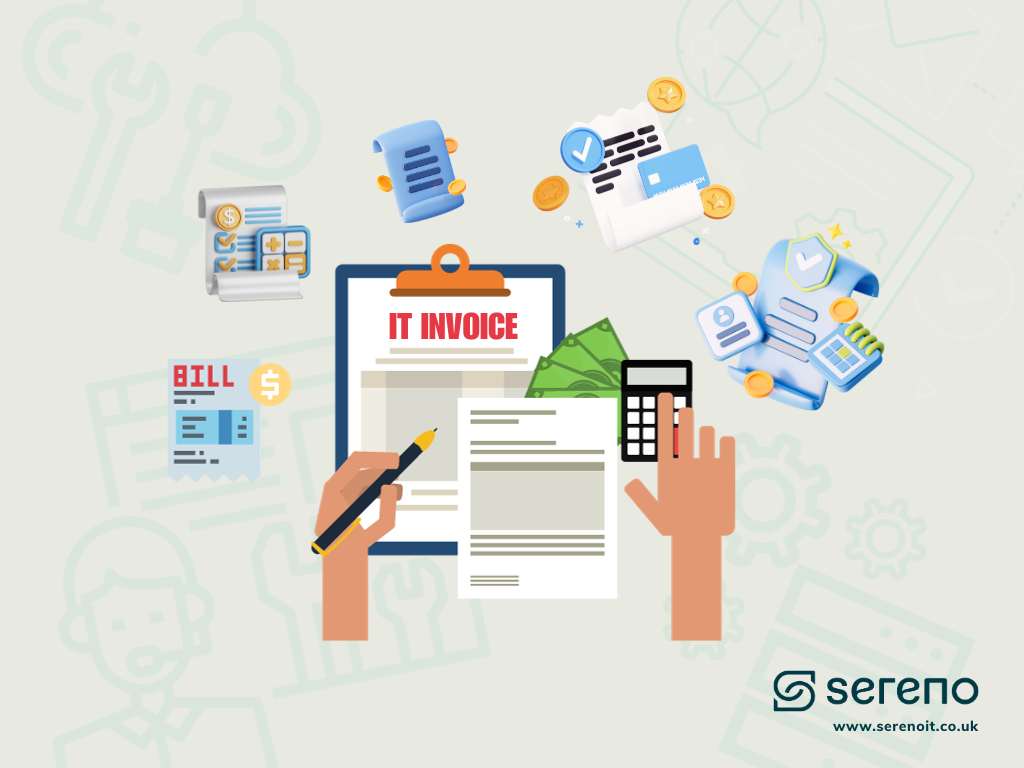
Navigating through IT invoices can often feel like unravelling a tangled web of different services, each tied to different aspects such as emails, devices, employees, and sites. In the quest for accuracy, many companies rely on their IT service providers to handle the intricacies of billing. However, rather than simplifying, IT companies can often add to this confusion with inaccurate or unclear billing, resulting in wasted time and growing frustration. In this article, we’ll delve into the common pitfalls of IT invoicing and explore the proactive measures we’ve implemented to prevent and address these issues.
Billing Types:
One of the primary challenges in IT invoicing lies with the varying types of billing for each service, often based on amounts of sites/offices, employees, emails, and devices. For example, your AntiVirus may be devices based, email SPAM filter email based, and Firewalls office based, which can and after do change over time. Vendors for these services can also bill differently, taking a number from the start or end of the month, billing in advance or arears, or charging for licensed or unlicensed email accounts. As most IT billing is now based around these types of ‘triggers’ let’s dive into these complexities and break down the challenges associated with them:
(For those still on a block-hour/PAYG type contracts we won’t be going into this in this article but check out our pricing page to understand why this method doesn’t benefit you long term.)
1 – Employee Billing:
Billing per user for the support service, as opposed to per device, is generally considered the most cost-effective method, as people often have multiple devices. As the IT provider manages new starters and leavers requests you would think this is simple to track, however this process still often has issues because manual intervention is required to update systems bringing inaccuracies and mistakes. Moreover, tracking or reporting these changes over time is difficult, and attempting to check numbers from historic months is close to impossible. Mid-month additions or departures further complicate the accuracy of billing, demanding a seamless process to ensure precision.
2 – Email Billing:
While managing email accounts and licenses may seem straightforward, nuances arise with licensed and non-licensed accounts, shared mailboxes, and distribution groups. The challenge lies in accurately reflecting licenses for live mailboxes in platforms like Microsoft 365 or Google. Manual processes for updating separate systems lead to discrepancies, with many companies blindly charging based on what they’re being charged by the vendor, rather than checking if this is accurate for the client – for example, email licenses not being removed when people leave.
3 – Device Billing:
Device-related billing poses its own set of challenges. Replacing a device in one month can result in double billing for device-based services, because a report shows 2 devices for that one employee in the month. However, removing a device from the management tool/system, to prevent it showing up and being billed for, requires careful consideration due to potential security implications. If a leavers device needs to be kept for a new starter in the future, do you remove it from management and security services, or do you leave it and continue to be billed? Due to this complexity its important to have an agreed process, with automation in place around the starter and leaver process or un-used devices.
Our Approach:
Having experienced the complexities surrounding IT invoicing, we made a conscious decision to simplify our billing process to ensure accuracy for our partners. We have automated all service billing behind two mechanisms, that are reliable and reportable. Let’s explore how we’ve streamlined billing for email, devices, and employees.
Email & Employee Billing:
We’ve linked email and employee billing, recognizing the intrinsic connection between the two. An integration into your email system identifies and differentiates between supported employees and consultants who require an email but are not supported. Our system then updates the employee list accordingly, and all employee-based billing is derived from this automated process. Email-based billing focuses solely on licensed mailboxes, ensuring accuracy and efficiency in our billing system.
Device Billing:
To simplify device billing, we’ve customized our employee leaver request form. Partners can specify whether a device should be wiped for recycling or retained for future use. We maintain essential services on retained devices for security purposes but automatically remove all services if the device remains offline for 90 days. This approach balances the need for security with the practicality of reusing devices while minimizing billing discrepancies.
That’s it. It’s really that simple.
Navigating the complexities of IT invoicing requires a customer-centric approach that prioritizes simplicity and accuracy. By us removing the intricacies of billing, we help companies save time, avoid frustration, and foster a more efficient working relationship with us. Our commitment is to make IT management, including billing, straightforward and hassle-free. Embracing a proactive and streamlined approach benefits both parties and contributes to a positive and productive collaboration.






